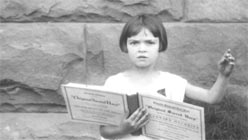Devotional music has a pretty bad rep among nonbelieving sections of the listening public. It’s easy to understand why if you have ever endured one of those interminable ads for mail-order-only collections of bland Christian rock on TV. Despite the existence of such unholy dross in this world (but hopefully not the next), there remains a rich seam of music inspired by the almighty that can stir the heart of even the most godless listener; it just doesn’t tend to be advertised on daytime cable.
The full-blooded harmonies of Sacred Harp singing is an ideal example. Few people have heard of this uniquely American choral tradition outside of the few Southern backwaters where it was born in the early 1800s. For two centures, small congregations have gathered for communal recitals known simply as a “singing.” But these are no ordinary church choirs. The music is rebellious in its disregard for musical convention, punk in its inclusivity, and powerful in a way that only music performed with true passion can be, regardless of what may have inspired it.
The first important thing you need to know about Sacred Harp music is there aren’t any harps involved. Sung without accompaniment, the name instead refers to the voice, our “god-given” instrument. There is no audience either, only participants. Individuals take turns to lead the group in a song, standing in the center of a square of singers, who all sit facing the middle. Each side of the square takes a different vocal part: treble, alto, tenor, and bass.
The music is written using a unique system of notation, with four notes (fa, sol, la, mi) represented by four shapes to make it easier to read (which gives rise to the tradition’s other name: shape-note music). These four notes, repeated to form the octave, are sung by name through the first verse of each song, before more conventional lyrics take over. That first run-through of nonsensical syllables evokes both the idea of singing in tongues, and the doo-doo-doo style harmonies of rock bands such as the Beach Boys (although a closer reference here might be the Langley Music Project‘s Beach Boys cover versions).


